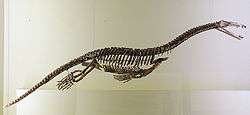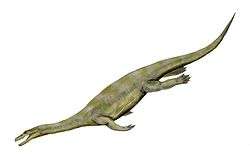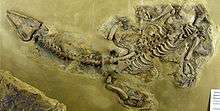Nothosaurus
| Nothosaurus Temporal range: 240–210 Ma | |
|---|---|
 | |
| Nothosaurus skeleton restoration in Berlin | |
| Scientific classification | |
| Kingdom: | Animalia |
| Phylum: | Chordata |
| Class: | Reptilia |
| Superorder: | †Sauropterygia |
| Order: | †Nothosauroidea |
| Family: | †Nothosauridae |
| Subfamily: | †Nothosaurinae Nopcsa, 1923 |
| Genus: | †Nothosaurus Münster, 1834 |
| Type species | |
| †Nothosaurus mirabilis Münster, 1834 | |
| Species | |
| |
| Synonyms | |
|
Genus synonymy
Species synonymy
| |
Nothosaurus ("false lizard", from the Ancient Greek nothos (νόθος), "illegitimate", and sauros (σαῦρος), "lizard") is an extinct genus of sauropterygian reptile from the Triassic period, approximately 240-210 million years ago, with fossils being distributed from North Africa and Europe to China. It is the best known member of the nothosaur order.
A complete skeleton of the species Nothosaurus raabi, now a synonym of N. marchicus, can be seen in the Natural History Museum in Berlin.
Palaeobiology

Nothosaurus was a semi-oceanic animal which probably had a lifestyle similar to that of today's seals. It was about 4 metres (13 ft), with long, webbed toes and possibly a fin on its tail.[1] When swimming, Nothosaurus would use its tail, legs, and webbed feet to propel and steer it through the water. The skull was broad and flat, with long jaws, lined with needle teeth, it probably caught fish and other marine creatures. Nothosaurus hunted by sneaking up slowly on prey, such as shoals of small fish, then putting on a last-minute burst of speed. Trackways attributed, partly by process of elimination, to a nothosaur, that were reported from Yunnan, China in June 2014, were interpreted as the paddle impressions left as the animals dug into soft seabed with rowing motions of their paddles, churning up hidden benthic creatures that they snapped up.[2] Once caught, few animals would be able to shake themselves free from the mouth of Nothosaurus.
In many respects its body structure resembled that of the much later plesiosaurs, but it was not as well adapted to an aquatic environment. It is thought that one branch of the nothosaurs may have evolved into plesiosaurs such as Liopleurodon, a short-necked plesiosaur that grew up to 6.4 metres (21 ft), and the long-necked Cryptoclidus, a fish eater with a neck as long as 1.3 metres (4.3 ft).
Species

There are over a dozen known species of Nothosaurus. The type species is N. mirabilis, named in 1834 from the Germanic Muschelkalk. Other species include N. giganteus (previously known as Paranothosaurus) from Osnabrück, Germany;[3] N. juvenilis, also from Germany;[4] N. edingerae from the Upper Muschelkalk and Lower Keuper;[5] N. haasi and N. tchernovi from Makhtesh Ramon, Israel;[6][7] N. cymatosauroides from the Spanish Muschelkalk;[8] N. jagisteus from the Upper Muschelkalk of Hohenlohe, Germany;[9] and N. youngi, N. yangjuanensis, N. rostellatus and the recently named gigantic N. zhangi from Guizhou, China.[10][11][12][13] Several species have been described from the Lower Muschelkalk in Winterswijk, the Netherlands, including N. marchicus[14] (and its junior synonym[15] N. winterswijkensis[14]) and the recently named N. winkelhorsti.[16]
| Cladogram of species of Nothosaurus | ||||||||||||||||||||||||||||||||||||||||||||||||
| ||||||||||||||||||||||||||||||||||||||||||||||||
| Klein and Albers (2009)[16] didn't test the monophyly of Nothosaurus, as other nothosaurids weren't included. |
Several other species have been named but are know generally considered invalid. One such species, N. procerus, is now considered a junior subjective synonym of N. marchicus.[17][18] Other species now considered junior synonyms of N. marchicus include N. crassus, N. oldenburgi, N. raabi, N. schroderi, N. venustus and the recently named N. winterswijkensis.[15] Junior synonyms of N. giganteus, the second largest Nothosaurus species, include N. andriani, N. angustifronis, N. aduncidens, N. baruthicus and N. chelydrops.[13]
A species level phylogenetic analysis of Nothosauridae was performed by Liu et al. (2014), and included all known valid species of the family and Nothosaurus apart from Lariosaurus stensioi (type of Micronothosaurus), Nothosaurus cymatosauroides, and Ceresiosaurus lanzi. Due to the inclusion of other nothosaurids other than Nothosaurus, the monophyly of Nothosaurus was tested for the first time. The analysis found both Lariosaurus and Nothosaurus to be polyphyletic in regard to each-other and all the other genera of the family, making a systematic revision of these two genera necessary. Below, their results are shown with type species of named nothosaurid genera noted.[13]
| |
| |||||||||||||||||||||||||||||||||||||||||||||||||||||||||||||||||||||||||||||||||||||||||||||||||||||||||||||||||||||
| |
References
- Parker, Steve. Dinosaurus: the complete guide to dinosaurs. Firefly Books Inc, 2003. Pg. 384
- ↑ Palmer, D., ed. (1999). The Marshall Illustrated Encyclopedia of Dinosaurs and Prehistoric Animals. London: Marshall Editions. p. 72. ISBN 1-84028-152-9.
- ↑ (LiveScience) Tia Ghose, "Ancient long-necked 'sea monsters' rowed their way to prey", reporting the scientific article published in Nature Communications 11 June 2014: accessed 28 November 2014.
- ↑ Diedrich, C. (2009). "The vertebrates of the Anisian/Ladinian boundary (Middle Triassic) from Bissendorf (NW Germany) and their contribution to the anatomy, palaeoecology, and palaeobiogeography of the Germanic Basin reptiles". Palaeogeography, Palaeoclimatology, Palaeoecology. 273 (1): 1–16. doi:10.1016/j.palaeo.2008.10.026.
- ↑ Rieppel, O. (1994). "The status of the sauropterygian reptile Nothosaurus juvenilis from the Middle Triassic of Germany". Palaeontology. 37: 733–745.
- ↑ Rieppel, O.; Wild, R. (1994). "Nothosaurus edingerae Schultze, 1970: diagnosis of the species and comments on its stratigraphical occurrence". Stuttgarter Beiträge für Naturkunde, Serie B.
- ↑ Rieppel, O.; Mazin, J.-M.; Tchernov, E. (1997). "Speciation along rifting continental margins: a new Nothosaur from the Negev (Israël)". Comptes Rendus de l'Académie des Sciences Series IIA. 325 (12): 991–997. doi:10.1016/s1251-8050(97)82380-4.
- ↑ Rieppel, O.; Mazin, J.-M.; Tchernov, E. (1999). "Sauropterygia from the Middle Triassic of Makhtesh Ramon, Negev, Israel". Fieldiana. 1 (40).
- ↑ Rieppel, O.; Hagdorn, H. (1998). "Fossil reptiles from the Spanish Muschelkalk (mont-ral and alcover, province Tarragona)". Historical Biology: An International Journal of Paleobiology. 13 (1): 77–97. doi:10.1080/08912969809386575.
- ↑ Shang, Q.-H. (2007). "New information on the dentition and tooth replacement of Nothosaurus (Reptilia: Sauropterygia)". Palaeoworld. 16: 254–263. doi:10.1016/j.palwor.2007.05.007.
- ↑ Li, J.; Rieppel, O. (2004). "A new nothosaur from Middle Triassic of Guizhou, China". Vertebrata PalAsiatica. 42 (1): 1–12.
- ↑ Jiang, W.; Maisch, M. W.; Hao, W.; Sun, Y.; Sun, Z. (2006). "Nothosaurus yangjuanensis n. sp. (Reptilia, Sauropterygia, Nothosauridae) from the middle Anisian (Middle Triassic) of Guizhou, southwestern China". NeuesJahrbuch für Geologie und Paläontologie, Monatshefte. 5: 257–276.
- ↑ Shang, Q.-H. (2006). "A new species of Nothosaurus from the early Middle Triassic of Guizhou,China". Vertebrata PalAsiatica. 44 (3): 237–249.
- 1 2 3 Jun Liu, Shi-xue Hu, Olivier Rieppel, Da-yong Jiang, Michael J. Benton, Neil P. Kelley, Jonathan C. Aitchison, Chang-yong Zhou, Wen Wen, Jin-yuan Huang, Tao Xie and Tao Lv (2014). "A gigantic nothosaur (Reptilia: Sauropterygia) from the Middle Triassic of SW China and its implication for the Triassic biotic recovery". Scientific Reports. 4: Article number 7142. doi:10.1038/srep07142.
- 1 2 Albers, P. C. H. (2005). "A new specimen of Nothosaurus marchicus with features that relate the taxon to Nothosaurus winterswijkensis". Vertebrate Palaeontology. 3 (1): 1–7.
- 1 2 Albers, P.C.H. (August 2011). "New Nothosaurus skulls from the Lower Muschelkalk of the western Lower Saxony Basin (Winterswijk, the Netherlands) shed new light on the status of Nothosaurus winterswijkensis". Netherlands Journal of Geosciences. 90 (1): 15–22. doi:10.1017/S0016774600000639.
- 1 2 Klein, N.; Albers, P. C. H. (2009). "A new species of the sauropsid reptile Nothosaurus from the Lower Muschelkalk of the western Germanic Basin, Winterswijk, The Netherlands". Acta Palaeontologica Polonica. 54 (4): 589–598. doi:10.4202/app.2008.0083.
- ↑ Schroder, H. (1914). "Wirbeltiere der Riidersdorfer Trias". Abhandlungen der Preussischen Geologischen Landesanstalt, Neue Folge. 65: 1–98.
- ↑ Rieppel, O.; Wild, R. (1996). "A revision of the genus Nothosaurus (Reptilia. Sauropterygia) from the Germanic Triassic with comments on the status of Conchiosaurus clavatus". Fieldiana. 1 (34): 1–82.
General references
- Dixon, Dougal (2006). The Complete Book of Dinosaurs. Hermes House.
- Haines, Tim, and Paul Chambers. The Complete Guide to Prehistoric Life. Pg. 64. Canada: Firefly Books Ltd., 2006